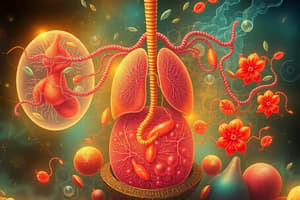Podcast
Questions and Answers
What causes the oxygen debt during anaerobic respiration in animals?
What causes the oxygen debt during anaerobic respiration in animals?
- The production of carbon dioxide
- The need to convert lactic acid (correct)
- The need for more glucose
- The breakdown of proteins
Which byproducts are produced during fermentation by yeast?
Which byproducts are produced during fermentation by yeast?
- Oxygen and glucose
- Water and glucose
- Lactic acid and water
- Alcohol (ethanol) and carbon dioxide (correct)
During recovery from anaerobic exercise, what is the primary reason for increased oxygen intake?
During recovery from anaerobic exercise, what is the primary reason for increased oxygen intake?
- To break down lactic acid (correct)
- To support aerobic respiration
- To replenish glucose stores
- To produce more energy
Which organisms primarily utilize anaerobic respiration?
Which organisms primarily utilize anaerobic respiration?
What is the primary difference in the products of aerobic versus anaerobic respiration?
What is the primary difference in the products of aerobic versus anaerobic respiration?
What is the role of carbon dioxide in anaerobic fermentation for bakers?
What is the role of carbon dioxide in anaerobic fermentation for bakers?
Which process is used in the brewing industry?
Which process is used in the brewing industry?
What happens to lactic acid after intense exercise in animals?
What happens to lactic acid after intense exercise in animals?
What is primarily needed to pay off the oxygen debt after anaerobic respiration in animals?
What is primarily needed to pay off the oxygen debt after anaerobic respiration in animals?
Which of the following substances is produced during anaerobic respiration in yeast?
Which of the following substances is produced during anaerobic respiration in yeast?
How does anaerobic respiration in microorganisms differ from aerobic respiration?
How does anaerobic respiration in microorganisms differ from aerobic respiration?
What is the main purpose of fermentation in the brewing industry?
What is the main purpose of fermentation in the brewing industry?
Which process is primarily associated with respiration in sports activities?
Which process is primarily associated with respiration in sports activities?
During anaerobic respiration, which of the following byproducts is produced in animals?
During anaerobic respiration, which of the following byproducts is produced in animals?
What is a common use for carbon dioxide produced during fermentation?
What is a common use for carbon dioxide produced during fermentation?
Which statement accurately describes the energy yield of anaerobic respiration compared to aerobic respiration?
Which statement accurately describes the energy yield of anaerobic respiration compared to aerobic respiration?
Flashcards are hidden until you start studying
Study Notes
Anaerobic Respiration in Animals
- Anaerobic respiration occurs when there is insufficient oxygen available for aerobic respiration.
- Lactic acid is produced as a byproduct during anaerobic respiration.
- The recovery period after exercise involves paying off the
oxygen debtto convert lactic acid into carbon dioxide and water.
Anaerobic Respiration in Microorganisms and Plants
- Some plants and yeast cells can respire without oxygen, a process called
fermentation. - During fermentation, glucose is converted into carbon dioxide and alcohol (ethanol).
- Fermentation is used in the brewing industry for beer and wine production.
- Bacteria also carry out anaerobic respiration to release energy from glucose.
- Yeast, a type of fungi, can also undergo fermentation.
Aerobic vs. Anaerobic Respiration
- Aerobic Respiration: Requires oxygen, produces carbon dioxide and water.
- Anaerobic Respiration: Does not require oxygen, produces lactic acid.
Respiration in Sports
- Anaerobic respiration is crucial for activities like weightlifting, sprinting, and powerlifting.
- Aerobic respiration is necessary for activities like long-distance running, swimming, cycling.
Anaerobic Respiration in Animals
- Anaerobic respiration occurs when there is a lack of oxygen.
- During anaerobic respiration, glucose is broken down to release energy.
- Lactic acid is a byproduct of anaerobic respiration.
- Oxygen debt refers to the amount of oxygen needed to recover from anaerobic respiration.
- The oxygen needed to pay back the oxygen debt is used to remove lactic acid.
- Lactic acid is converted to carbon dioxide and water during recovery.
Anaerobic Respiration in Microorganisms and Plants
- Some plants and yeast cells can respire without oxygen.
- This process is called fermentation.
- Fermentation produces carbon dioxide and alcohol (ethanol).
- Fermentation is used by brewers, winemakers, and bakers.
- Bacteria also carry out anaerobic respiration to release energy from glucose.
Comparison of Aerobic and Anaerobic Respiration
- Aerobic respiration requires oxygen.
- Anaerobic respiration does not require oxygen.
- Both aerobic and anaerobic respiration require glucose.
- Aerobic respiration produces carbon dioxide and water as byproducts.
- Anaerobic respiration produces lactic acid as a byproduct.
Respiration in Sports
- Anaerobic respiration is important in high-intensity activities such as weightlifting.
- Aerobic respiration is important in long-duration activities such as running.
- The type of respiration used depends on the intensity and duration of the activity.
Studying That Suits You
Use AI to generate personalized quizzes and flashcards to suit your learning preferences.




